Challenges and Implications of Migrant Nurses in Global Health
VerifiedAdded on 2023/06/08
|6
|1830
|171
Report
AI Summary
This report examines the significant challenges faced by migrant nurses worldwide, focusing on the impact of migration on both developing and developed countries. It analyzes factors such as language barriers, discrimination, and work environment issues, highlighting the stress and potential job dissatisfaction experienced by these nurses. The report reviews relevant literature, including studies on job satisfaction, communication difficulties, and the effects of unequal treatment. It evaluates the contributions of migrant nurses and discusses the recommendations provided by the World Health Organization (WHO) to address these challenges. The implications of these issues are discussed, including the need for supportive work environments, professional development opportunities, and effective coping strategies. The report emphasizes the importance of ethical recruitment practices, international cooperation, and the implementation of information systems to support migrant nurses and improve healthcare outcomes globally. The conclusion reinforces the need for proactive measures to protect and support migrant nurses in order to strengthen healthcare systems worldwide.
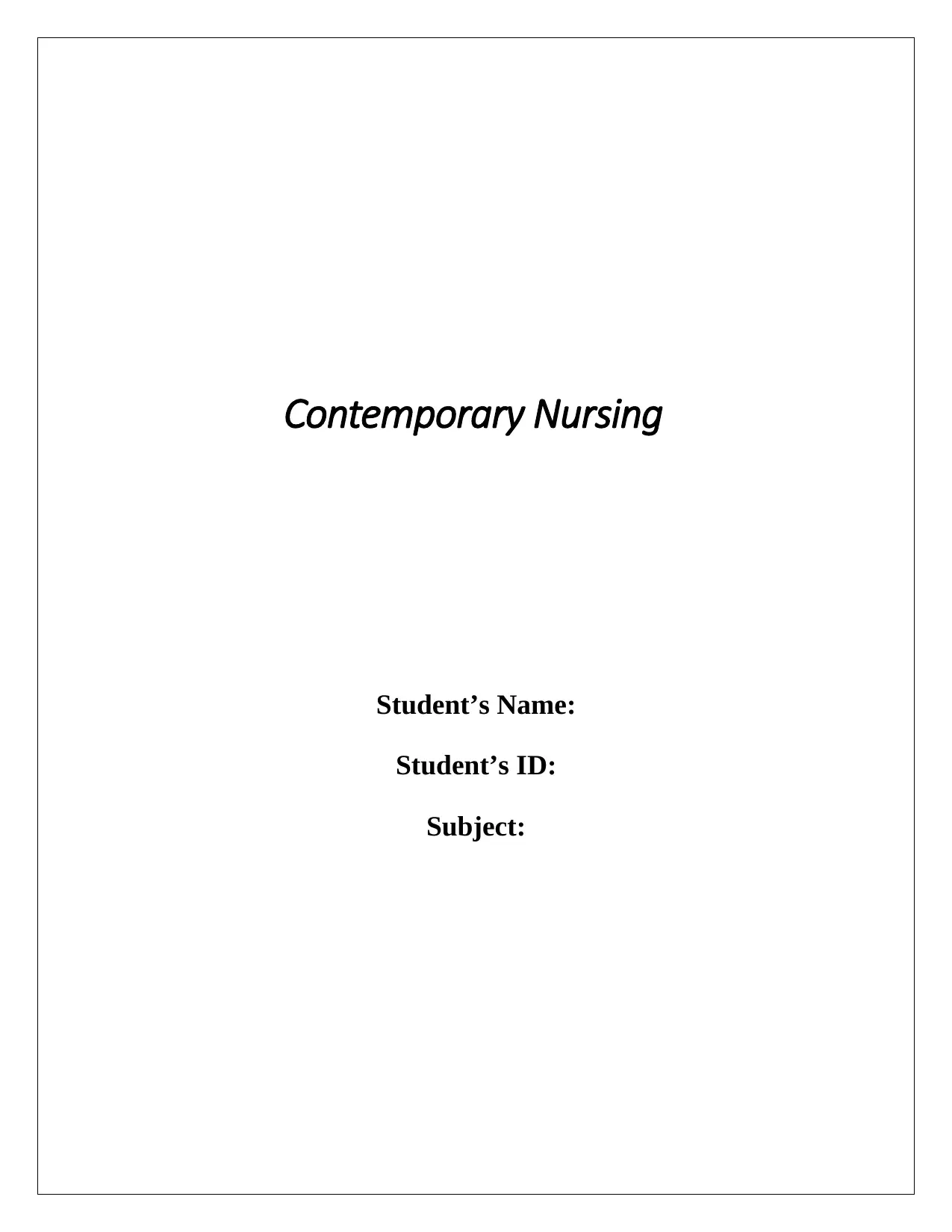
Contemporary Nursing
Student’s Name:
Student’s ID:
Subject:
Student’s Name:
Student’s ID:
Subject:
Paraphrase This Document
Need a fresh take? Get an instant paraphrase of this document with our AI Paraphraser
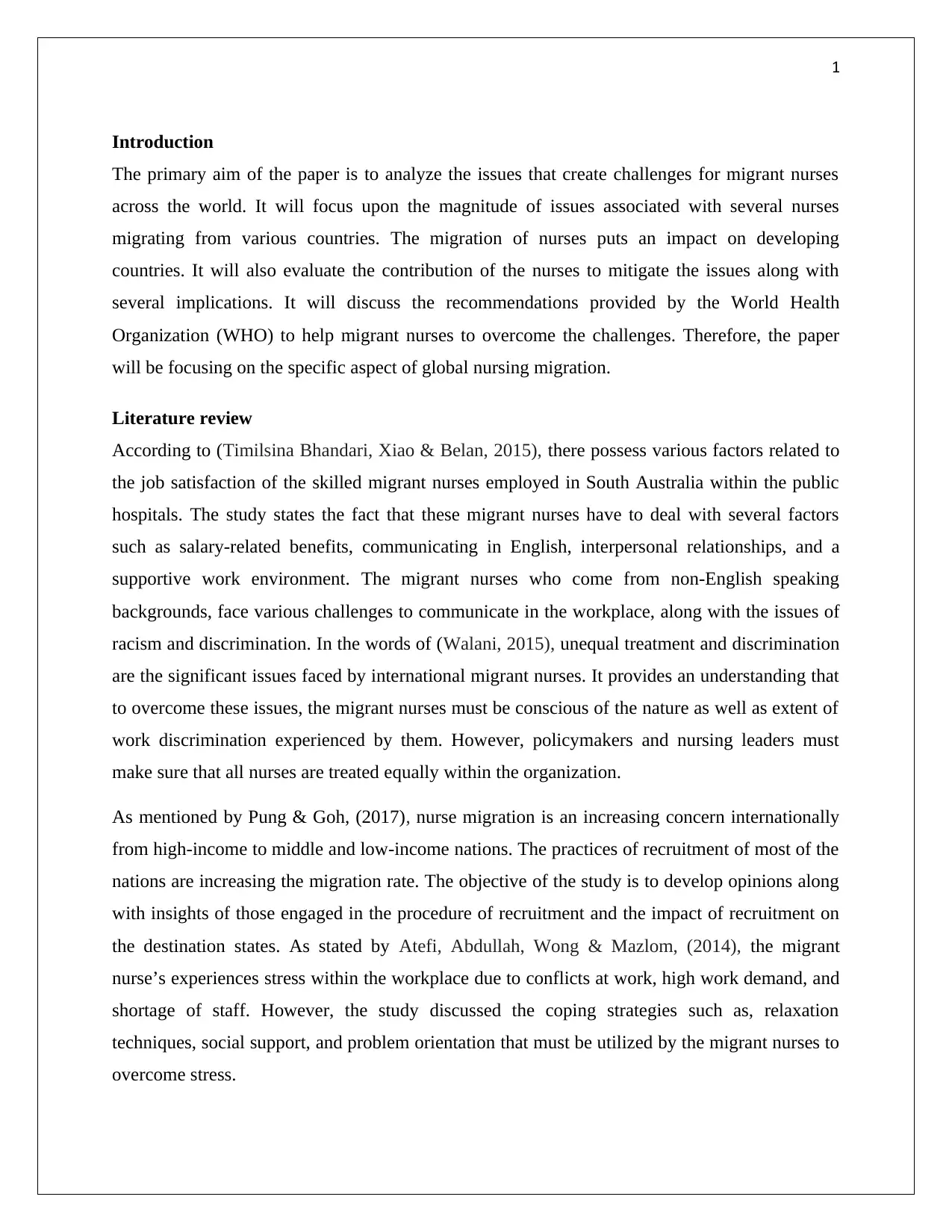
1
Introduction
The primary aim of the paper is to analyze the issues that create challenges for migrant nurses
across the world. It will focus upon the magnitude of issues associated with several nurses
migrating from various countries. The migration of nurses puts an impact on developing
countries. It will also evaluate the contribution of the nurses to mitigate the issues along with
several implications. It will discuss the recommendations provided by the World Health
Organization (WHO) to help migrant nurses to overcome the challenges. Therefore, the paper
will be focusing on the specific aspect of global nursing migration.
Literature review
According to (Timilsina Bhandari, Xiao & Belan, 2015), there possess various factors related to
the job satisfaction of the skilled migrant nurses employed in South Australia within the public
hospitals. The study states the fact that these migrant nurses have to deal with several factors
such as salary-related benefits, communicating in English, interpersonal relationships, and a
supportive work environment. The migrant nurses who come from non-English speaking
backgrounds, face various challenges to communicate in the workplace, along with the issues of
racism and discrimination. In the words of (Walani, 2015), unequal treatment and discrimination
are the significant issues faced by international migrant nurses. It provides an understanding that
to overcome these issues, the migrant nurses must be conscious of the nature as well as extent of
work discrimination experienced by them. However, policymakers and nursing leaders must
make sure that all nurses are treated equally within the organization.
As mentioned by Pung & Goh, (2017), nurse migration is an increasing concern internationally
from high-income to middle and low-income nations. The practices of recruitment of most of the
nations are increasing the migration rate. The objective of the study is to develop opinions along
with insights of those engaged in the procedure of recruitment and the impact of recruitment on
the destination states. As stated by Atefi, Abdullah, Wong & Mazlom, (2014), the migrant
nurse’s experiences stress within the workplace due to conflicts at work, high work demand, and
shortage of staff. However, the study discussed the coping strategies such as, relaxation
techniques, social support, and problem orientation that must be utilized by the migrant nurses to
overcome stress.
Introduction
The primary aim of the paper is to analyze the issues that create challenges for migrant nurses
across the world. It will focus upon the magnitude of issues associated with several nurses
migrating from various countries. The migration of nurses puts an impact on developing
countries. It will also evaluate the contribution of the nurses to mitigate the issues along with
several implications. It will discuss the recommendations provided by the World Health
Organization (WHO) to help migrant nurses to overcome the challenges. Therefore, the paper
will be focusing on the specific aspect of global nursing migration.
Literature review
According to (Timilsina Bhandari, Xiao & Belan, 2015), there possess various factors related to
the job satisfaction of the skilled migrant nurses employed in South Australia within the public
hospitals. The study states the fact that these migrant nurses have to deal with several factors
such as salary-related benefits, communicating in English, interpersonal relationships, and a
supportive work environment. The migrant nurses who come from non-English speaking
backgrounds, face various challenges to communicate in the workplace, along with the issues of
racism and discrimination. In the words of (Walani, 2015), unequal treatment and discrimination
are the significant issues faced by international migrant nurses. It provides an understanding that
to overcome these issues, the migrant nurses must be conscious of the nature as well as extent of
work discrimination experienced by them. However, policymakers and nursing leaders must
make sure that all nurses are treated equally within the organization.
As mentioned by Pung & Goh, (2017), nurse migration is an increasing concern internationally
from high-income to middle and low-income nations. The practices of recruitment of most of the
nations are increasing the migration rate. The objective of the study is to develop opinions along
with insights of those engaged in the procedure of recruitment and the impact of recruitment on
the destination states. As stated by Atefi, Abdullah, Wong & Mazlom, (2014), the migrant
nurse’s experiences stress within the workplace due to conflicts at work, high work demand, and
shortage of staff. However, the study discussed the coping strategies such as, relaxation
techniques, social support, and problem orientation that must be utilized by the migrant nurses to
overcome stress.
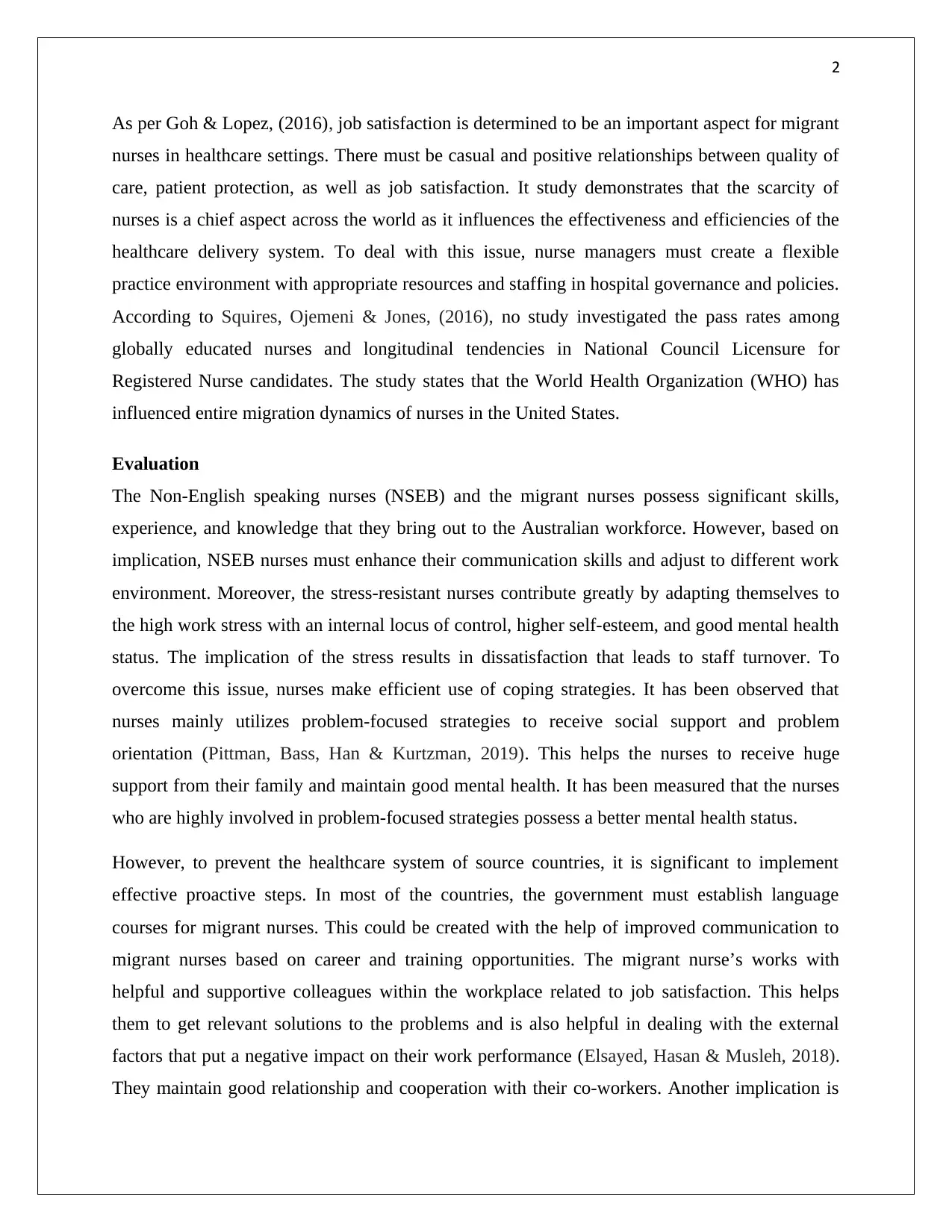
2
As per Goh & Lopez, (2016), job satisfaction is determined to be an important aspect for migrant
nurses in healthcare settings. There must be casual and positive relationships between quality of
care, patient protection, as well as job satisfaction. It study demonstrates that the scarcity of
nurses is a chief aspect across the world as it influences the effectiveness and efficiencies of the
healthcare delivery system. To deal with this issue, nurse managers must create a flexible
practice environment with appropriate resources and staffing in hospital governance and policies.
According to Squires, Ojemeni & Jones, (2016), no study investigated the pass rates among
globally educated nurses and longitudinal tendencies in National Council Licensure for
Registered Nurse candidates. The study states that the World Health Organization (WHO) has
influenced entire migration dynamics of nurses in the United States.
Evaluation
The Non-English speaking nurses (NSEB) and the migrant nurses possess significant skills,
experience, and knowledge that they bring out to the Australian workforce. However, based on
implication, NSEB nurses must enhance their communication skills and adjust to different work
environment. Moreover, the stress-resistant nurses contribute greatly by adapting themselves to
the high work stress with an internal locus of control, higher self-esteem, and good mental health
status. The implication of the stress results in dissatisfaction that leads to staff turnover. To
overcome this issue, nurses make efficient use of coping strategies. It has been observed that
nurses mainly utilizes problem-focused strategies to receive social support and problem
orientation (Pittman, Bass, Han & Kurtzman, 2019). This helps the nurses to receive huge
support from their family and maintain good mental health. It has been measured that the nurses
who are highly involved in problem-focused strategies possess a better mental health status.
However, to prevent the healthcare system of source countries, it is significant to implement
effective proactive steps. In most of the countries, the government must establish language
courses for migrant nurses. This could be created with the help of improved communication to
migrant nurses based on career and training opportunities. The migrant nurse’s works with
helpful and supportive colleagues within the workplace related to job satisfaction. This helps
them to get relevant solutions to the problems and is also helpful in dealing with the external
factors that put a negative impact on their work performance (Elsayed, Hasan & Musleh, 2018).
They maintain good relationship and cooperation with their co-workers. Another implication is
As per Goh & Lopez, (2016), job satisfaction is determined to be an important aspect for migrant
nurses in healthcare settings. There must be casual and positive relationships between quality of
care, patient protection, as well as job satisfaction. It study demonstrates that the scarcity of
nurses is a chief aspect across the world as it influences the effectiveness and efficiencies of the
healthcare delivery system. To deal with this issue, nurse managers must create a flexible
practice environment with appropriate resources and staffing in hospital governance and policies.
According to Squires, Ojemeni & Jones, (2016), no study investigated the pass rates among
globally educated nurses and longitudinal tendencies in National Council Licensure for
Registered Nurse candidates. The study states that the World Health Organization (WHO) has
influenced entire migration dynamics of nurses in the United States.
Evaluation
The Non-English speaking nurses (NSEB) and the migrant nurses possess significant skills,
experience, and knowledge that they bring out to the Australian workforce. However, based on
implication, NSEB nurses must enhance their communication skills and adjust to different work
environment. Moreover, the stress-resistant nurses contribute greatly by adapting themselves to
the high work stress with an internal locus of control, higher self-esteem, and good mental health
status. The implication of the stress results in dissatisfaction that leads to staff turnover. To
overcome this issue, nurses make efficient use of coping strategies. It has been observed that
nurses mainly utilizes problem-focused strategies to receive social support and problem
orientation (Pittman, Bass, Han & Kurtzman, 2019). This helps the nurses to receive huge
support from their family and maintain good mental health. It has been measured that the nurses
who are highly involved in problem-focused strategies possess a better mental health status.
However, to prevent the healthcare system of source countries, it is significant to implement
effective proactive steps. In most of the countries, the government must establish language
courses for migrant nurses. This could be created with the help of improved communication to
migrant nurses based on career and training opportunities. The migrant nurse’s works with
helpful and supportive colleagues within the workplace related to job satisfaction. This helps
them to get relevant solutions to the problems and is also helpful in dealing with the external
factors that put a negative impact on their work performance (Elsayed, Hasan & Musleh, 2018).
They maintain good relationship and cooperation with their co-workers. Another implication is
⊘ This is a preview!⊘
Do you want full access?
Subscribe today to unlock all pages.

Trusted by 1+ million students worldwide
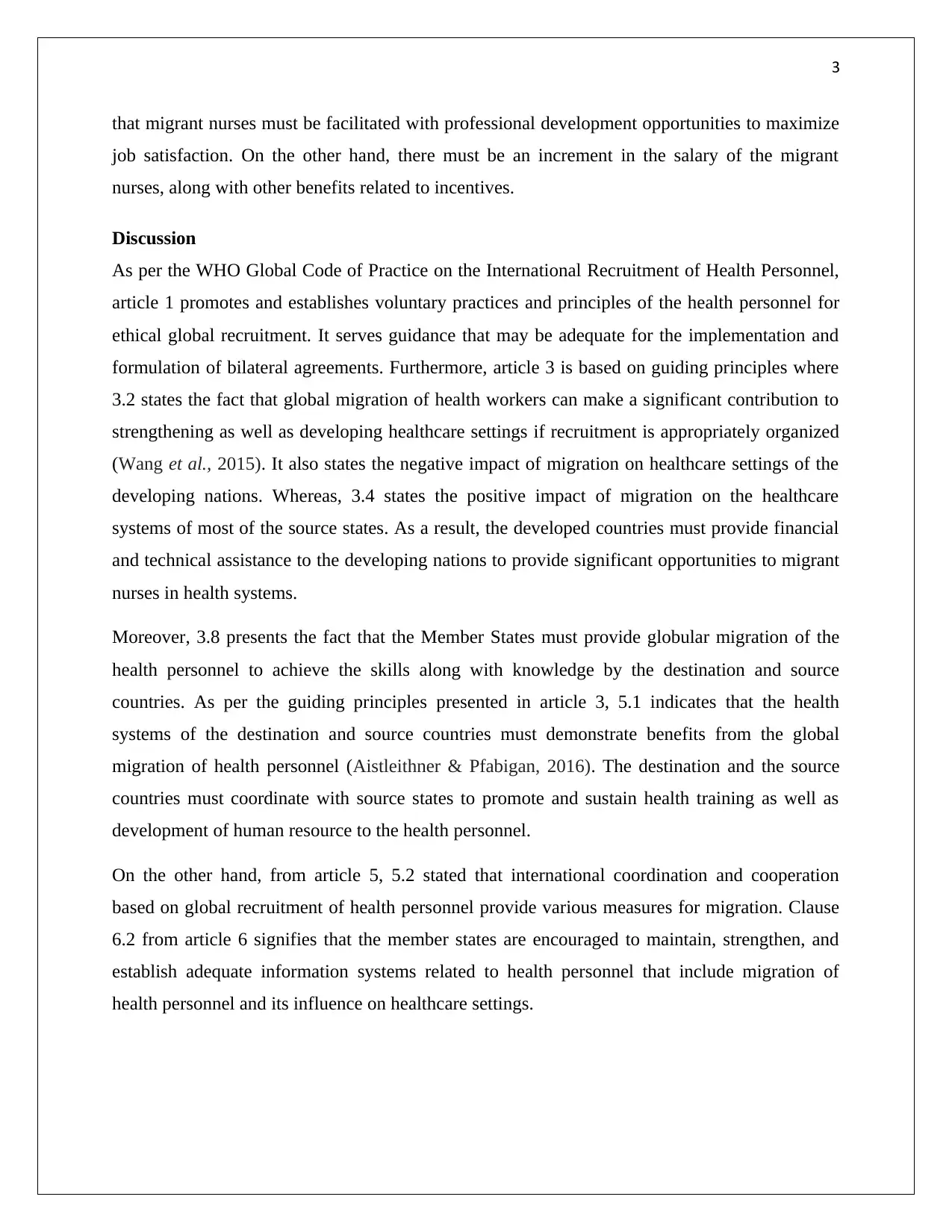
3
that migrant nurses must be facilitated with professional development opportunities to maximize
job satisfaction. On the other hand, there must be an increment in the salary of the migrant
nurses, along with other benefits related to incentives.
Discussion
As per the WHO Global Code of Practice on the International Recruitment of Health Personnel,
article 1 promotes and establishes voluntary practices and principles of the health personnel for
ethical global recruitment. It serves guidance that may be adequate for the implementation and
formulation of bilateral agreements. Furthermore, article 3 is based on guiding principles where
3.2 states the fact that global migration of health workers can make a significant contribution to
strengthening as well as developing healthcare settings if recruitment is appropriately organized
(Wang et al., 2015). It also states the negative impact of migration on healthcare settings of the
developing nations. Whereas, 3.4 states the positive impact of migration on the healthcare
systems of most of the source states. As a result, the developed countries must provide financial
and technical assistance to the developing nations to provide significant opportunities to migrant
nurses in health systems.
Moreover, 3.8 presents the fact that the Member States must provide globular migration of the
health personnel to achieve the skills along with knowledge by the destination and source
countries. As per the guiding principles presented in article 3, 5.1 indicates that the health
systems of the destination and source countries must demonstrate benefits from the global
migration of health personnel (Aistleithner & Pfabigan, 2016). The destination and the source
countries must coordinate with source states to promote and sustain health training as well as
development of human resource to the health personnel.
On the other hand, from article 5, 5.2 stated that international coordination and cooperation
based on global recruitment of health personnel provide various measures for migration. Clause
6.2 from article 6 signifies that the member states are encouraged to maintain, strengthen, and
establish adequate information systems related to health personnel that include migration of
health personnel and its influence on healthcare settings.
that migrant nurses must be facilitated with professional development opportunities to maximize
job satisfaction. On the other hand, there must be an increment in the salary of the migrant
nurses, along with other benefits related to incentives.
Discussion
As per the WHO Global Code of Practice on the International Recruitment of Health Personnel,
article 1 promotes and establishes voluntary practices and principles of the health personnel for
ethical global recruitment. It serves guidance that may be adequate for the implementation and
formulation of bilateral agreements. Furthermore, article 3 is based on guiding principles where
3.2 states the fact that global migration of health workers can make a significant contribution to
strengthening as well as developing healthcare settings if recruitment is appropriately organized
(Wang et al., 2015). It also states the negative impact of migration on healthcare settings of the
developing nations. Whereas, 3.4 states the positive impact of migration on the healthcare
systems of most of the source states. As a result, the developed countries must provide financial
and technical assistance to the developing nations to provide significant opportunities to migrant
nurses in health systems.
Moreover, 3.8 presents the fact that the Member States must provide globular migration of the
health personnel to achieve the skills along with knowledge by the destination and source
countries. As per the guiding principles presented in article 3, 5.1 indicates that the health
systems of the destination and source countries must demonstrate benefits from the global
migration of health personnel (Aistleithner & Pfabigan, 2016). The destination and the source
countries must coordinate with source states to promote and sustain health training as well as
development of human resource to the health personnel.
On the other hand, from article 5, 5.2 stated that international coordination and cooperation
based on global recruitment of health personnel provide various measures for migration. Clause
6.2 from article 6 signifies that the member states are encouraged to maintain, strengthen, and
establish adequate information systems related to health personnel that include migration of
health personnel and its influence on healthcare settings.
Paraphrase This Document
Need a fresh take? Get an instant paraphrase of this document with our AI Paraphraser
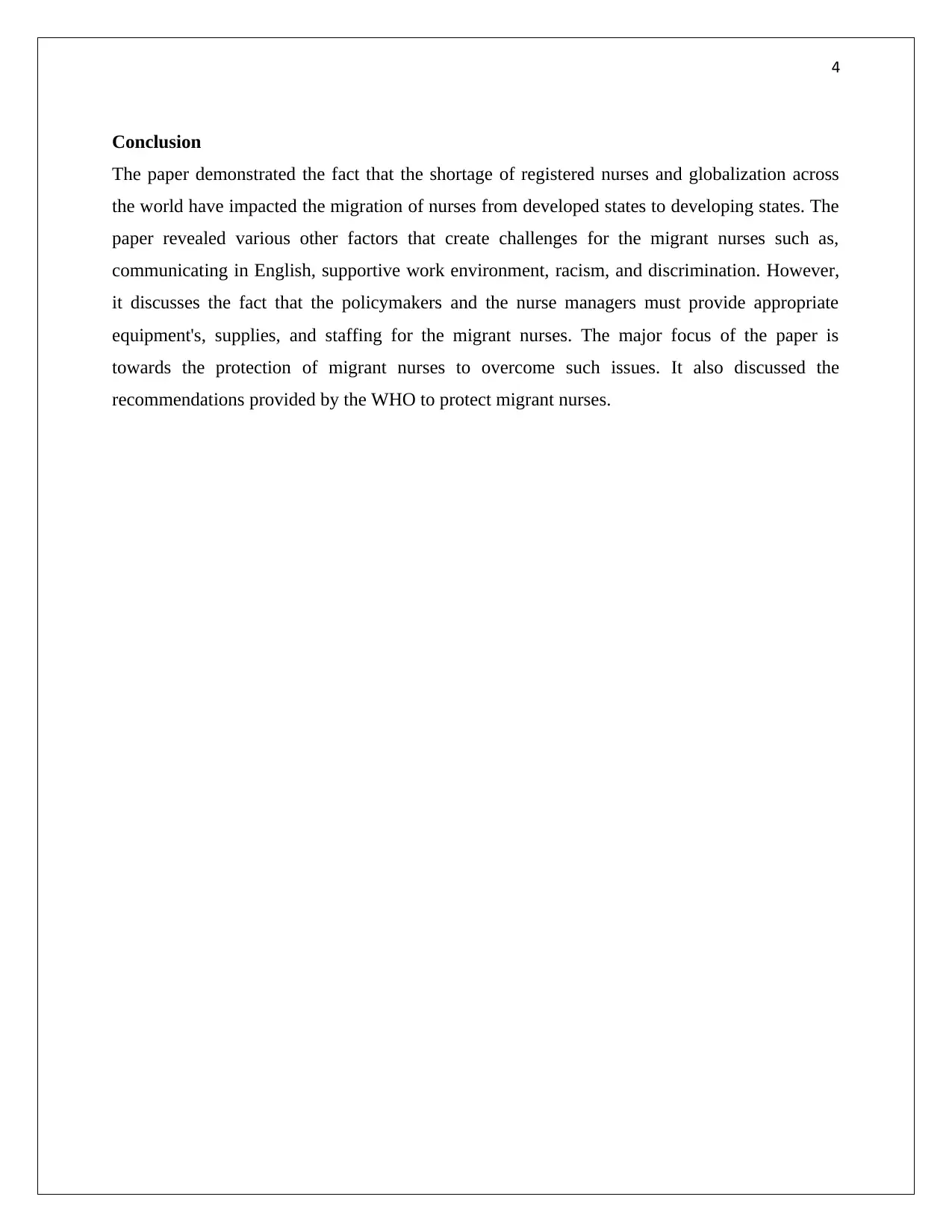
4
Conclusion
The paper demonstrated the fact that the shortage of registered nurses and globalization across
the world have impacted the migration of nurses from developed states to developing states. The
paper revealed various other factors that create challenges for the migrant nurses such as,
communicating in English, supportive work environment, racism, and discrimination. However,
it discusses the fact that the policymakers and the nurse managers must provide appropriate
equipment's, supplies, and staffing for the migrant nurses. The major focus of the paper is
towards the protection of migrant nurses to overcome such issues. It also discussed the
recommendations provided by the WHO to protect migrant nurses.
Conclusion
The paper demonstrated the fact that the shortage of registered nurses and globalization across
the world have impacted the migration of nurses from developed states to developing states. The
paper revealed various other factors that create challenges for the migrant nurses such as,
communicating in English, supportive work environment, racism, and discrimination. However,
it discusses the fact that the policymakers and the nurse managers must provide appropriate
equipment's, supplies, and staffing for the migrant nurses. The major focus of the paper is
towards the protection of migrant nurses to overcome such issues. It also discussed the
recommendations provided by the WHO to protect migrant nurses.
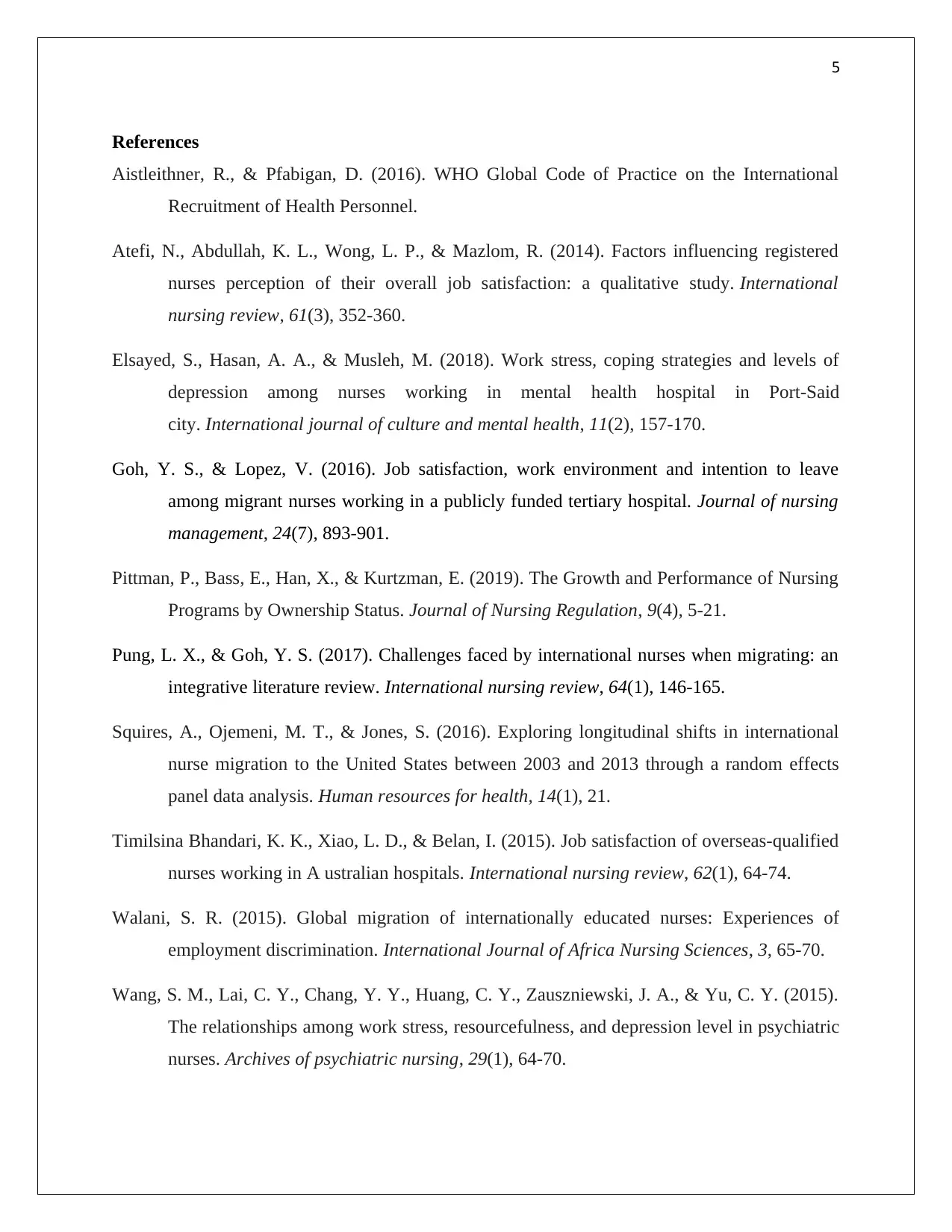
5
References
Aistleithner, R., & Pfabigan, D. (2016). WHO Global Code of Practice on the International
Recruitment of Health Personnel.
Atefi, N., Abdullah, K. L., Wong, L. P., & Mazlom, R. (2014). Factors influencing registered
nurses perception of their overall job satisfaction: a qualitative study. International
nursing review, 61(3), 352-360.
Elsayed, S., Hasan, A. A., & Musleh, M. (2018). Work stress, coping strategies and levels of
depression among nurses working in mental health hospital in Port-Said
city. International journal of culture and mental health, 11(2), 157-170.
Goh, Y. S., & Lopez, V. (2016). Job satisfaction, work environment and intention to leave
among migrant nurses working in a publicly funded tertiary hospital. Journal of nursing
management, 24(7), 893-901.
Pittman, P., Bass, E., Han, X., & Kurtzman, E. (2019). The Growth and Performance of Nursing
Programs by Ownership Status. Journal of Nursing Regulation, 9(4), 5-21.
Pung, L. X., & Goh, Y. S. (2017). Challenges faced by international nurses when migrating: an
integrative literature review. International nursing review, 64(1), 146-165.
Squires, A., Ojemeni, M. T., & Jones, S. (2016). Exploring longitudinal shifts in international
nurse migration to the United States between 2003 and 2013 through a random effects
panel data analysis. Human resources for health, 14(1), 21.
Timilsina Bhandari, K. K., Xiao, L. D., & Belan, I. (2015). Job satisfaction of overseas‐qualified
nurses working in A ustralian hospitals. International nursing review, 62(1), 64-74.
Walani, S. R. (2015). Global migration of internationally educated nurses: Experiences of
employment discrimination. International Journal of Africa Nursing Sciences, 3, 65-70.
Wang, S. M., Lai, C. Y., Chang, Y. Y., Huang, C. Y., Zauszniewski, J. A., & Yu, C. Y. (2015).
The relationships among work stress, resourcefulness, and depression level in psychiatric
nurses. Archives of psychiatric nursing, 29(1), 64-70.
References
Aistleithner, R., & Pfabigan, D. (2016). WHO Global Code of Practice on the International
Recruitment of Health Personnel.
Atefi, N., Abdullah, K. L., Wong, L. P., & Mazlom, R. (2014). Factors influencing registered
nurses perception of their overall job satisfaction: a qualitative study. International
nursing review, 61(3), 352-360.
Elsayed, S., Hasan, A. A., & Musleh, M. (2018). Work stress, coping strategies and levels of
depression among nurses working in mental health hospital in Port-Said
city. International journal of culture and mental health, 11(2), 157-170.
Goh, Y. S., & Lopez, V. (2016). Job satisfaction, work environment and intention to leave
among migrant nurses working in a publicly funded tertiary hospital. Journal of nursing
management, 24(7), 893-901.
Pittman, P., Bass, E., Han, X., & Kurtzman, E. (2019). The Growth and Performance of Nursing
Programs by Ownership Status. Journal of Nursing Regulation, 9(4), 5-21.
Pung, L. X., & Goh, Y. S. (2017). Challenges faced by international nurses when migrating: an
integrative literature review. International nursing review, 64(1), 146-165.
Squires, A., Ojemeni, M. T., & Jones, S. (2016). Exploring longitudinal shifts in international
nurse migration to the United States between 2003 and 2013 through a random effects
panel data analysis. Human resources for health, 14(1), 21.
Timilsina Bhandari, K. K., Xiao, L. D., & Belan, I. (2015). Job satisfaction of overseas‐qualified
nurses working in A ustralian hospitals. International nursing review, 62(1), 64-74.
Walani, S. R. (2015). Global migration of internationally educated nurses: Experiences of
employment discrimination. International Journal of Africa Nursing Sciences, 3, 65-70.
Wang, S. M., Lai, C. Y., Chang, Y. Y., Huang, C. Y., Zauszniewski, J. A., & Yu, C. Y. (2015).
The relationships among work stress, resourcefulness, and depression level in psychiatric
nurses. Archives of psychiatric nursing, 29(1), 64-70.
⊘ This is a preview!⊘
Do you want full access?
Subscribe today to unlock all pages.

Trusted by 1+ million students worldwide
1 out of 6
Related Documents
Your All-in-One AI-Powered Toolkit for Academic Success.
+13062052269
info@desklib.com
Available 24*7 on WhatsApp / Email
![[object Object]](/_next/static/media/star-bottom.7253800d.svg)
Unlock your academic potential
Copyright © 2020–2025 A2Z Services. All Rights Reserved. Developed and managed by ZUCOL.





